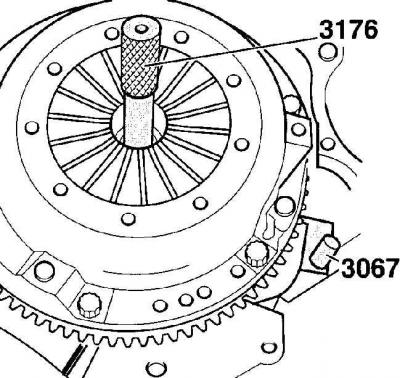Using tools to remove and install the clutch disc

- 3067 - a device for fixing the flywheel from turning
- 3176 - mandrel for centering the clutch disc
Warning: Clutch operation generates dust that contains asbestos, which is harmful to health, so when cleaning the clutch, do not use compressed air or inhale the dust. Clean the clutch parts from dust using brake fluid or methyl alcohol. After cleaning the clutch parts with methanol or brake fluid, wipe the parts dry.
Removing
1. Remove the gearbox.
2. Mark the position of the clutch master assembly in relation to the flywheel using a marker or paint.
3. Using the special tool VW-3067 or a screwdriver, block the flywheel from turning by the teeth of the flywheel ring gear, see fig. Using tools to remove and install the clutch disc).
4. Gradually, in a diagonal sequence, loosen the master clutch mounting bolts by turning each bolt half a turn until the spring action stops and the bolts can be unscrewed by hand.
5. Remove the pressure plate while supporting the clutch plate so that it does not fall.
6. Wipe the flywheel with gasoline.
Examination
Places to check the pressure diaphragm spring for wear

Directions in which it is necessary to check the condition of the release bearing

1. Check the condition of the clutch pressure plate. The traces of wear at the ends of the pressure spring should be no more than 0.3 mm, see fig. Places to check the pressure diaphragm spring for wear.
2. Check the tightness of the spring connection between the pressure plate and the clutch drive housing. Scratches and missing or damaged rivets are not allowed.

3. Check the pressure plate for cracks, burn marks and surface wear. Using a steel ruler and a feeler blade, check the flatness of the working surface of the pressure plate. The flatness of the pressure plate must not exceed 0.2 mm.
4. Check the condition of the friction surface of the flywheel for cracks, burn marks and surface wear.
5. Check the condition of the friction linings of the clutch disc and if there are traces of oil or mechanical damage on them, replace the clutch disc.
6. Measure the thickness of the clutch disc linings. If their thickness is less than acceptable or if the rivet heads are close to the working surface, replace them or the clutch disc.

7. Check the end play of the clutch disc, which at a distance of 2.5 mm from the outer diameter should be no more than 0.8 mm.
8. Check the condition of the release bearing, which should rotate easily, evenly and silently, and there should be no play in it. The working surface of the bearing acting on the pressure spring must be smooth, without cracks, local corrosion or wear (see fig. Directions in which it is necessary to check the condition of the release bearing).
A faulty release bearing can be determined without removing it from the vehicle, for which it is necessary to press the clutch pedal with the engine running. If there is additional noise when you press the clutch pedal, then the release bearing is defective and needs to be replaced.
Installation
Centering the clutch disc, in relation to the leading part of the clutch, with a special mandrel 2174

Warning: When installing a new clutch disc or clutch pressure plate, remove the anti-corrosion protection from them.
Warning: When installing the clutch disc, make sure that even small amounts of oil do not get on its friction linings. Therefore, before installing the clutch disc, wipe the mating surface of the flywheel and the surface of the pressure plate with a clean rag, and install the clutch disc with clean hands.
1. Lubricate the splines in the clutch disc hub with a thin layer of special grease based on molybdenum disulphide.
2. Install the clutch disc on the flywheel with the protrusion of the clutch disc hub pointing outward, i.e. towards the gearbox.
3. Install the clutch drive on the disc while placing it on the drive pins. When reinstalling a previously removed clutch drive plate, check that the marks applied before removal are aligned.
4. Tighten the bolts of the leading part of the clutch so that the clutch disc is pressed, but at the same time can still move to the sides.
5. Using a special mandrel or an old gearbox input shaft, center the clutch disc on the flywheel, see fig. Use of tools when removing and installing the clutch disc.
6. The centering of the clutch disc in relation to the leading part of the clutch can be done before installing the leading part of the clutch with a special mandrel 2174, see fig. Centering the clutch disc, in relation to the leading part of the clutch, with a special mandrel 2174.
7. After centering the clutch disc, gradually and diagonally tighten the bolts for fastening the leading part of the clutch to a torque of 25 Nm.
8. Remove the mandrel from the clutch disc.
9. Lubricate the spline of the gearbox input shaft and the release bearing guide bushing with a thin layer of special grease based on molybdenum disulphide.
10. Install the gearbox.

Visitor comments